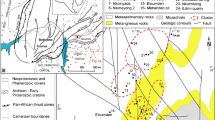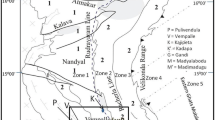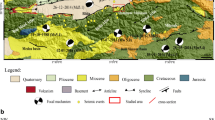Abstract
This study has documented the structural and stratigraphic investigations of the Darwaza, Tajwal, Masot, Bhurban, Dewal, and Malkot areas of Murree and KPK, Pakistan. The proposed territory is positioned along the western limb of the Hazara Kashmir syntaxis (HKS). The HKS is an anti-formal hairpin-like architecture, which is seismically an active folded-and-thrust belt in the sub-Himalayas of Pakistan. It was studied using the Kink method (stratigraphic and structural analysis) combined with detailed field observations. The results reveal that the sedimentary rock sequence is fully exposed to the area from the Middle Jurassic (Samana Suk Formation) to date (Quaternary alluvium). Structurally, the study area is highly deformed. Two main deformational episodes (D1 and D2) were recognized. D1 deformation is characterized by tight to isoclinal folds with penetrative axial plane cleavage, axes plunging N43°E/80°NW, and interlimb angle 03–05°, whereas D2 deformation is categorized by open to gentle-style folds with an axial plane ranging from N28°E/68° SE to N50°E/86°NW and an interlimb angle of 95–122°. Moreover, faults and folds are present in the area. Sandh overturned syncline, Sandh anticline, Sandh syncline, Daryagali anticline, Tandoi syncline, Bhurban anticline, and Potha syncline are the major folds. These folds are northwest verging and southeast or southwest plunging. These are isoclinal to gentle folds. The Darwaza fault, Masot fault, and Main Boundary Thrust (MBT) are the major faults in the study area. These faults are northeast–southwest trending and dip to the northwest, thus forming thrust-fault–related folds.









Similar content being viewed by others
Data availability
Data are openly available in a public repository.
References
Ahsan N, Chaudhry MN (2008) Geology of Hettangian to middle Eocene rocks of Hazara and Kashmir basins, Northwest lesser Himalayas Pakistan. Geol Bull Punjab Univ 43:131–152
Ahsan N, Chaudhry N, Muhammad M, Khan Z (2009) Allai Aggregate for rehibilitation and reconstruction of October 8, 2005 earthquake affected Allai-Banan area. Punjab Univ, NWFP. Geol. Bull, p 44
Akhtar S, Rahim Y, Hu B, Tsang H, Ibrar KM, Ullah MF, Bute SI (2019) Stratigraphy and structure of Dhamtaur area, District Abbottabad, Eastern Hazara Pakistan. Open J Geol 9(01):57
Ali A, Faisal S, Rehman K, Khan S, Ullah N (2015) Tectonic imprints of the Hazara Kashmir Syntaxis on the Northwest Himalayan Fold and thrust belt North Pakistan. Arab J Geosci 8(11):9857–9876
Ali A, Habib U, Rehman U, Atta Z, Ul A, Muhammad I (2016) Tectonic imprints of the Hazara Kashmir syntaxis on the Mesozoic rocks exposed in Munda, Mohmand Agency, Northwest Pakistan. Acta Geol Sin - English Edition 90:440–455
Ali F (2014) Tectonic evolution of the Margala hills and a part of the south eastern Hazara ranges. University of Peshawar, Pakistan
Baig MS (2006) Active faulting and earthquake deformation in Hazara-Kashmir syntaxis, Azad Kashmir, Northwest Himalaya, Pakistan. In Extended Abstracts, International Conference on 8 October 2005 Earthquake in Pakistan: Its Implications and Hazard Mitigation, Islamabad, Pakistan, 18–19 January 2006 (pp. 27-28). Geological Survey of Pakistan: Islamabad, Pakistan
Baig MS, Munir MuH (2007) Foraminiferal biostratigraphy of Yadgar area, Muzaffarabad Azad Kashmir, Pakistan. J Himalayan Earth Sci 40:33–43
Baig MS, Yeats RS, Pervez S, Jadoon IA, Khan MR, Sidiqui I et al (2010) Active tectonics, October 8, 2005 earthquake deformation, active uplift, scarp morphology and seismic geohazards microzonation, Hazara-Kashmir syntaxis, Northwest Himalayas Pakistan. J Himal Earth Sci 43:17–21
Baig MS, Lawrence RD (1987) Precambrian to early Paleozoic orogenesis in the Himalaya. Kashmir J Geol 5:1–22
Bossart P, Dietrich D, Greco A, Ottiger R, Ramsay J (1988) The tectonic structure of the Hazara-Kashmir syntaxis, Southern Himalayas, Pakistan. Tectonics 7:273–297
Bossart P, Ottiger R, Heller F (1990) Rock magnetic properties and structural development in the core of the Hazara-Kashmir syntaxis, NE Pakistan. Tectonics 9:103–121
Burg J-P, Célérier B, Chaudhry NM, Ghazanfar M, Gnehm F, Schnellmann M (2005) Fault analysis and paleostress evolution in large strain regions: methodological and geological discussion of the southeastern Himalayan fold-and-thrust belt in Pakistan. J Asian Earth Sci 24(4):445–467
Calkins JA (1966) The geology of the western limb of the Hazara-Kashmir syntaxis. The Pennsylvania State University, West Pakistan and Kashmir
Calkins JA, Tw O, Skm A (1975) Geology of the Southern Himalaya in Hazara , Pakistan and adjacent areas. Geol Surv USA 716:1–29
Coward MP, Rex DC, Khan MA, Windley BF, Broughton RD, Luff IW et al (1986) Collision tectonics in the NW Himalayas. Geol Soc Spec Publ London 19(1):203–219
Coward MP, Butler RWH, Chambers AF, Graham RH, Izatt CN, Khan MA et al (1988) Folding and imbrication of the Indian crust during Himalayan collision Philosophical Transactions of the Royal Society of London. Series A, Math Phys Sci 326(1589):89–116
Crawford AR, Davies RG (1975) Ages of pre-Mesozoic formations of the Lesser Himalaya, Hazara District Northern Pakistan. Geol Mag 112:509–514
Davies LM (1930) The fossil fauna of the Samana Range and some neighbouring areas; part I. An introductory note. Mem Geol Surv India Palaeontol Ind New Ser 15:1–15
DiPietro JA, Pogue KR (2004) Tectonostratigraphic subdivisions of the Himalaya: a view from the west. Tectonics 23(5):TC5001
Gansser A (1964) Geology of the Himalayas. Interscience Publishers London etc. J.Wiley & Sons, pp 1–289
Greco A (1991) Stratigraphy metamorphism and tectonics of the Hazara-Kashmir syntaxis area. Kash J Geol 8:939–965
Guillot S, Mahéo G, De Sigoyer J, Hattori KH, Pecher A (2008) Tethyan and Indian subduction viewed from the Himalayan high-toultrahigh-pressure metamorphic rocks. Tectonophysics 451(1–4):225–241
Iqbal O, Baig MS, Pervez S, Ṣiddiqi MI (2018) Structure and stratigraphy of Rumbli and Panjar areas of Kashmir and Pakistan with the aid of GIS. J Geol Soc India 91:57–66
Iqbal MZ, Li W, Ali A, Liu Y, Zhang D (2020) Clockwise hairpin-type metamorphic pressure–temperature (P–T) path recorded in the Shangla blueschist along the Indus Suture Zone. Pakistan Himalaya. Geological J 55(11):7548–7563
Khan MM, Sajid S, Jadoon QA, Umar M, Khan AA (2021) Sedimentary evolution of middle Jurassic epeiric carbonate ramp Hazara Basin Lesser Himalaya Pakistan. Carbonates Evaporites 36(3):1–21
Latif MA (1970) Explanatory notes on the geology of South Eastern Hazara, to accompany the revised geological map. Wien Jb. Geol, BA, Sonderb, p 15
Latif MA, Yasin AR, Shafique NA, Ashraf MA (1995) Late Mesozoic sedimentary megacycle in the rifted Haro Trough, Hazara, Pakistan and its hydrocarbon implications in the northern rim of the North West Himalayan Basin. Pakistan J Hydrocarb Res 7:31–52
Lisa M, Khan SA, Khwaja AA (2004) Focal mechanism study of north Potwar deformed zone, Pakistan. Acta Seismologica Sinica 17:255–261
Lydekker R (1883) The geology of the Kashmir and Chamba territories, and the British district of Khagan. Geological Survey Office 1883
Middlemiss CS (1896) The geology of Hazara and the Black Mountain (Vol. 26). Geological Survey 1896
Molnar PH, Tapponnier PE (1975) Cenozoic tectonics of Asia: effects of a continental collision: features of recent continental tectonics in Asia can be interpreted as results of the India-Eurasia collision. Science 189(4201):419–426
Munir H, Kashmir M, Mirza K (2007) Stratigraphic aspect of recent earthquake occurred along the Balakot-Bagh fault, North-West Himalayas, Pakistan. Geol Bull Punjab Univ 42(2007):25–36
Paul OJ, Dar RA, Romshoo SA (2021) Paleo-glacial and paleo-equilibrium line altitude reconstruction from the late Quaternary glacier features in the Pir Panjal Range, NW Himalayas. Quat Int 642:5–16
Qasim M, Khan MA, Haneef M (2014) Stratigraphic characterization of the early Cambrian Abbottabad formation in the Sherwan area, Hazara region, N. Pakistan: implications for early Paleozoic stratigraphic correlation in NW Himalayas, Pakistan. J Himal Earth Sci 47(1):25–40
Qasim M, Khan MA, Haneef M (2015) Stratigraphic characterization and structural analysis of the northwestern Hazara Ranges across Panjal Thrust, Northern Pakistan. Arab J Geosci 8:7811–7829
Rahim Y, Khan MS, Mughal S (2018) Petrography of sandstone of the Lumshiwal formation from eastern Hazara, Khyber Pakhtunkhwa, Pakistan: implications for provenance, diagenesis and environments of deposition. Earth Sci Pakistan (ESP) 2(2):1–6
Ramsay JG (1980) Shear zone geometry: a review. J Struct Geol 2:83–99
Rowley DB (1996) Age of initiation of collision between India and Asia: a review of stratigraphic data. Earth Planet Sci Lett 145(1-4):1–13
Searle MP (2019) Timing of subduction initiation, arc formation, ophiolite obduction and India–Asia collision in the Himalaya. Geol Soc Spec Publ London 483(1):19–37
Shah MM, Ahmed W, Ahsan N, Lisa M (2016) Fault-controlled, bedding-parallel dolomite in the middle Jurassic Samana Suk Formation in Margalla Hill Ranges, Khanpur area (North Pakistan): petrography, geochemistry, and petrophysical characteristics. Arab J Geosci 9(5):1–18
Sorkhabi RB, Macfarlane AM (1999) Himalaya and Tibet: mountain roots to mountain tops. In: Geological Society of America, Special Paper 328, Eos, Transactions. American Geophysical Union, pp 508–508
Umar M, Sabir MA, Farooq M, Khan MM, Sajid S, Faridullah F, Jadoon UK, Khan AS (2015) Stratigraphic and sedimentological attributes in Hazara Basin Lesser Himalaya, North Pakistan: their role in deciphering minerals potential. Arab J Geosci 8:1653–1667
Wadia DN (1928) The geology of Poonch State (Kashmir) and adjacent portions of the Punjab. Mem Geol Surv India 51:185–370
Wadia DN (1931) The syntaxis of the northwest Himalaya: Its rocks, tectonics and orogeny. Rec GSI 65(2):189–220
White NM, Pringle M, Garzanti E, Bickle M, Najman Y, Chapman H, Friend P (2002) Constraints on the exhumation and erosion of the high Himalayan slab, NW India, from foreland basin deposits. Earth Planet Sci Lett 195(1-2):29–44
Yeats RS, Hussain A (1987) Timing of structural events in the Himalayan foothills of northwestern Pakistan. Geol Soc Am Bull 99(2):161–176
Zubair RA, Long X, Baig MS (2022) Structural geometry, kinematics and paleostress of the Main Boundary Thrust: new constraints from the Hazara-Kashmir syntaxis, Northwest Himalayas Pakistan. J Asian Earth Sci 228:105129
Acknowledgements
We gratefully acknowledge the Department of Geology (Structure Geology Lab), University of Azad Jammu and Kashmir for providing logistical support during this research. We would also like to thank the editor and anonymous reviewers for helpful comments that helped clarify our results. We wish to acknowledge Prof. Dr. Mirza Shaid Baig, Asst. Prof. Shahab Parviz, and others for their help during the fieldwork.
Funding
This work is supported by the National Nature Sciences Foundation of China (Grant Nos. 41872235, 42172236, and 41872233), the Youth Innovation Team of Shaanxi Universities, and the Fundamental Research Funds for the Central Universities of China (Grant Nos. 300102270202, 202110710062, and 300103183081).
Author information
Authors and Affiliations
Corresponding author
Ethics declarations
Conflict of interest
The author(s) declare that they have no competing interests.
Additional information
Responsible Editor: François Roure
Supplementary information
ESM 1
(DOCX 2999 kb)
Rights and permissions
Springer Nature or its licensor (e.g. a society or other partner) holds exclusive rights to this article under a publishing agreement with the author(s) or other rightsholder(s); author self-archiving of the accepted manuscript version of this article is solely governed by the terms of such publishing agreement and applicable law.
About this article
Cite this article
Hussain, I., Li, ZC., Fida, M. et al. Sub-Himalayan Mesozoic-Cenozoic tectonic-stratigraphic properties and deformation features in the western limb of Hazara Kashmir syntaxis, Pakistan. Arab J Geosci 17, 16 (2024). https://doi.org/10.1007/s12517-023-11817-z
Received:
Accepted:
Published:
DOI: https://doi.org/10.1007/s12517-023-11817-z




